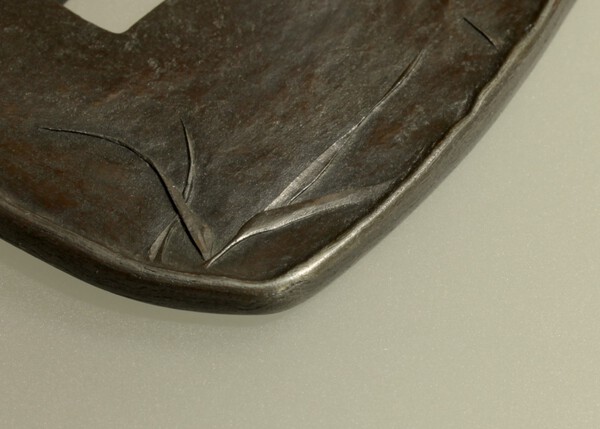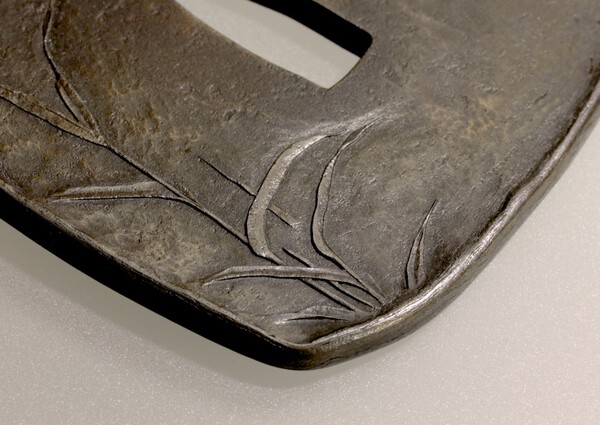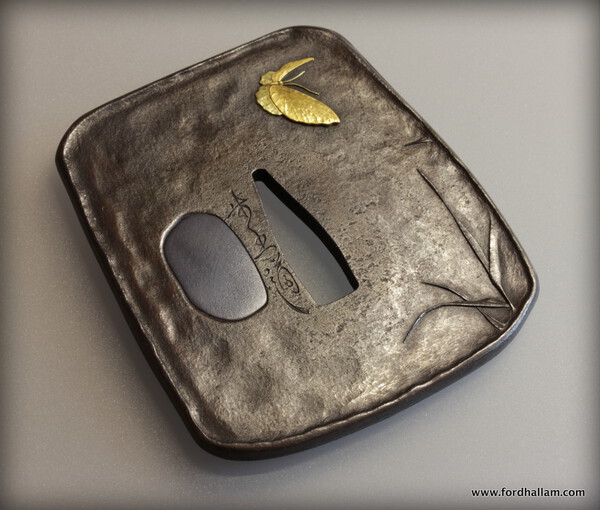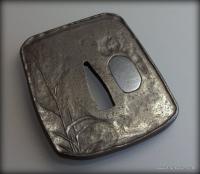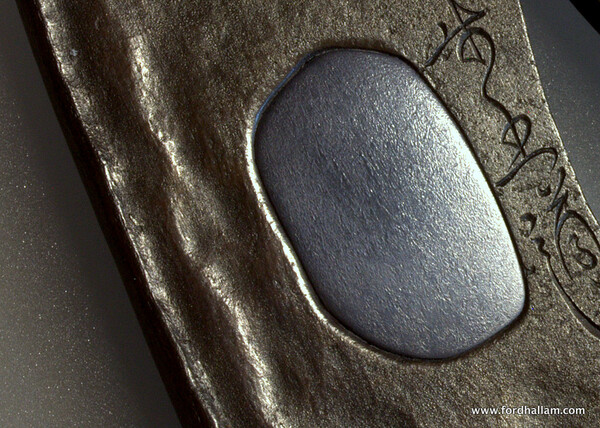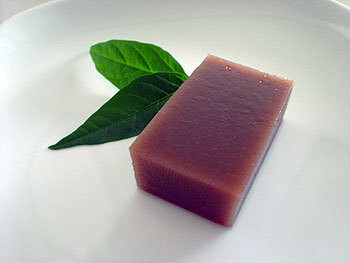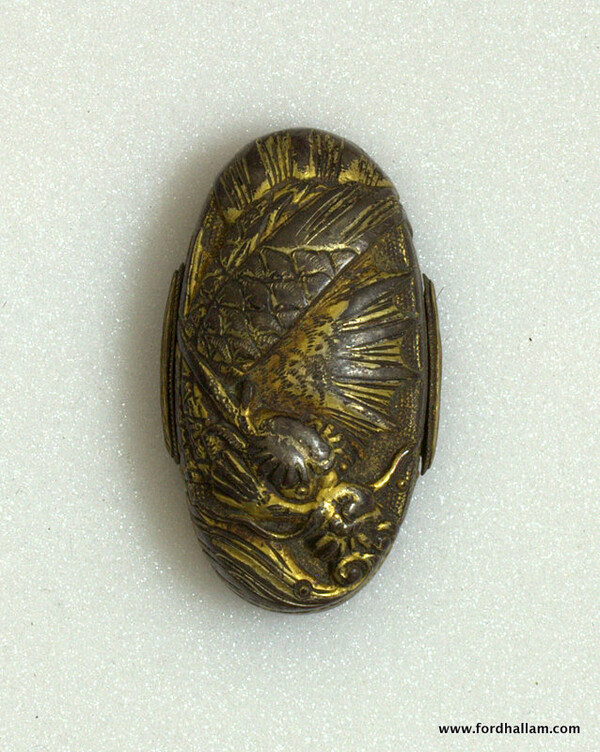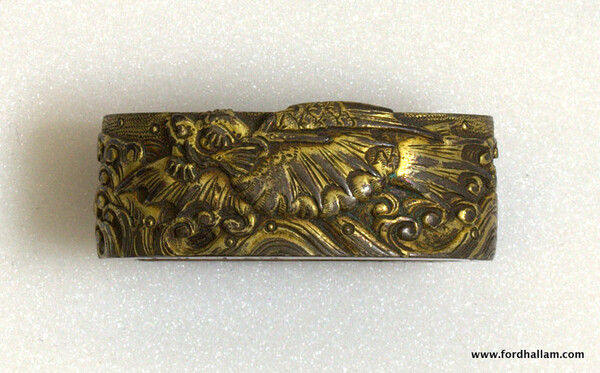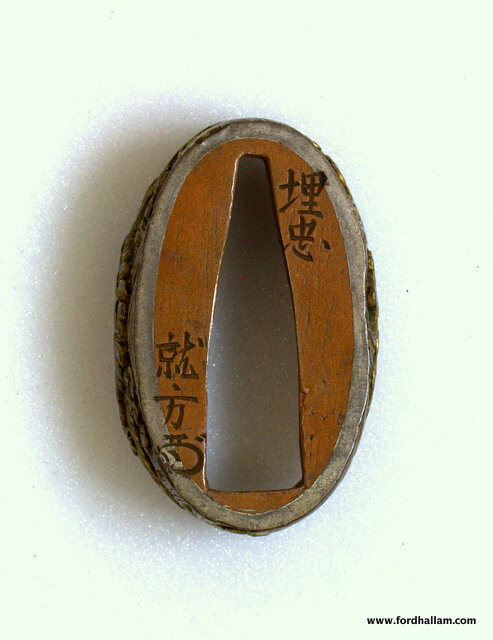-
Posts
3,091 -
Joined
-
Days Won
78
Content Type
Profiles
Forums
Events
Store
Downloads
Gallery
Everything posted by Ford Hallam
-
Junichi you got me...all those books I referenced were really just a smokescreen for the fact everything I know about the samurai class and Edo life I learned from Kurosawa movies. Evidently, for the past 20 years or so, professional scholars and researchers have similarly been swayed by Kurosawa despite a wealth of actual period documentation. I suppose that in any dictatorial situation there will always be those who, when given the chance, will join the ranks of the oppressors. It doesn't take a lot of study to learn that very human fact. But these rather bold claims will take some evidence in the form of actual examples and comparisons to sustain. Did they?....can't say I've noticed it much in tosogu. Agan, examples please... The general public! more like the wealthy merchant elite. As for bling bling...Goto black and gold is pretty bling, as is Ishiguro work. Shakudo nanako signals nothing but very expensive extravagance. In fact on the whole the machibori are far less bling bling than the Iebori schools. To characterise the merchant taste as merely bling bling is to ignore the entirety of Edo period art but perhaps thet's the problem with these narrow samurai/tosogu focused view-points. And why are they now hopelessly resigned if they have the chance to elevate themselves to exhaulted samurai class? I have to say, Junichi, your description of elements the warrior class being all deep, meaningful and stoically, yet subtly, resistant to the Bakufu versus the shallow, 'bling bling' loving, prostitute visiting townsmen does rather paint you as a bit of a propagandist/apologist for the Samurai class. Seems to me you're trying to create a narrative that fits your preconceptions without first exploring the evidence objectively. I'd suggest that anyone wanting to more realistically explore this idea might consider the penchant for ancient Chinese themes in Machibori work. These relate to Confucian ideals, wise Emperors, Sages and honourable warriors. These can easily be seen as a witty expression that highlighted the very failings of the Bakufu that made life difficult for the commoners. The most familiar subject would be that of Shoki persuing the Oni. I needn't elaborate on the symbolism, I trust.
-
it seems that the topic I've touched on, that of commoner and warrior relations in the Edo period is probably too complex to properly characterise in forum posts but as I've offered a few thoughts already I feel it important to at least add one more salient feature. That being the actual economic realities both faced. The fact is, the economic growth during the Tokugawa period was bad for the samurai but good for the commoners. "While they were not shy about commenting wryly on the state of society, urban commoners were not political activists. Peasant protests did break out in the eighteenth century,largely due to authorities’ failure to provide relief during times of crop failure and food shortage. But the new urban bourgeoisie did not attempt to overthrow the warrior government. Rather, urban commoners tended to turn away from the troublesome world of politics. They used their newfound wealth to fashion a new style of life and art. While the new style borrowed aspects of elite “high” culture, it was in many ways utterly new to the early modern urban scene. By the Genroku period (1688-1703), one could see in Edo and other cities a flourishing merchant class that was developing a cultural style all its own. Merchants flaunted their wealth, building enormous houses and dressing in finery that exceeded that of samurai. The shogunate was not at all happy about this. It repeatedly issued laws forbidding merchants to wear fine silk clothes and restricting the construction of large and showy homes in merchant quarters." [Tokugawa Japan: An Introductory Essay by Marcia Yonemoto, 2008]
-
"By now you are running out of feet to shoot yourself in." and it's good to see these menuki recognised as being decent quality though personally speaking I still doubt the Misumi attribuition on the grounds they're actually better than Misumi's work as illustrated in Ito's books.
-
Cheers Stephen, it was a fun job. The sort of cunning work I really relish, where the restoration is invisible. Interestingly the various inlays are of differning coppers. As the dragon was origionally gilded this wasn't a concern but now it's quite apparent but neer the less an intersting feature. I used a piece of copper I'd previously made up that contained arsenic, lead and a hint of tin to simulate niguromé, which is what the rest of the copper looks like.
-
Junichi It may be true that within the ruling class there were always resistant factions to the centralised goverement but, never the less , on the whole the Samurai class oppressed everyone else. Surely you can't disagree with that statement. It's worth remembering that the warrior class only comprised 7 to 10% of the population yet for the most part discussions here seem to evolve around Samurai history, which is understandable, but it does present a very one-sided view of social history in Japan. And just to be clear, central goverment tended to focus on the capital city in terms of social control while local Daimyo were left to control and tax their own subjects. The Daimyo were then subject to levies and regulation by the bakufu. Trade out of Nagasaki was an exception as it was a very important economic centre for the goverment and they kept a close eye on matters there. And yes, there are records of merchants buying status but this hardly suggests that as a group they aspired to be warrior class but rather merely that certain individuals wanted increased percieved social standing and perhaps the concomitant business advantage their new position bought. A close reading of various social histories makes the relationships between the warrior class and the rest very clear. In fact extant records make for facinating reading and the constant attempts by the bakufu and Han leaders to regulate and censor the populace are almost amusing in that they reveal a society continually wriggling to find ways to escape this restrictive control. Remember also that the Edo period was an era of increasing taxation and regular periods of famine when starving commoners rioted in desperate attempts avoid staving to death. A too successful merchant who flouted his wealth might easily find everything confiscated and himself banished to some backwater. The warrior class were seen by the general populace as parasitic, capricious and dangerous. And it is in this almost nihlistic context to life we find the townspeople 'living for the day' and in many subtle ways 'flipping the bird' to their overlords. Not a great deal of love lost there. As for evidence of resistance to state oppression as expressed in fittings you'd have to look to other art forms. This is generally discussed in most books on Edo period art. And it wasn't the warrior class making the art The Iebori were the ones following the rules and expressing the officially approved taste while the Machibori lived as Chōnin. This is why Machibori work is so lively and innovative while the Iebori just kept doing what they'd always done. Mining, Monies, and Culture in Early Modern Societies Market Integration and Famines in Early Modern Japan Japan to 1600: A Social and Economic History Handbook to Life in Medieval and Early Modern Japan Lust, Commerce, and Corruption: An Account of What I Have Seen and Heard, by an Edo Samurai (Translations from the Asian Classics) Kaempfer's Japan: Tokugawa Culture Observed
-
Pete, I merely refered to the 'Higo style' as this is what we now recognise Sansai's origional expression as having inspired. My point being that what we now recognise as Higo style derives from what he did and is not in it's reiterations really in any meaningful way expressively original, merely fashion. The reference in his aesthetic to the cult of tea was previously acknowledged when I pointed out the preference of unmatching items used in that ceremony.
-
Happy to add food for thought, Barrie :-) It occured to me, thinking further about the Higo 'style', that far from being truly idiosyncratic the reiterations of the style Hosokawa Sansai created are not creative expressions at all. For the most part they, yet again, follow prescribed rules. It's an interesting to consider genuine creativity in the face of an essentially conformist social structure.
-
Hello Barrie As John pointed out and you asked, yes, there are times when a matched set can look quite good and even appropriate. I merely offered that bit of info as a counter to what seemed like a pretty one-sided view-point being expressed on that other thread But the military mind is not the most natural ground for irregularity and apparent haphazardness. The Shogunate and the warrior class in general were pretty uptight bunch really. Despite the whitewashing we're talking about an oppresive military dictatorship. They liked things kept in order and in their place. It was the Chōnin (townsmen) who were the real arbiters of taste and style in the Edo period and for the most part they regarded the warrior class as unrefined and boorish. An intelligently and sensitively put together set of apparently mismatched fitting would signal the taste of a confidant and singular aesthetic mind. A well known example might be the Kasen koshirae puported to have been 'designed' by Hosokawa Sansai, the higo Daimyō. In fact it's a feature of Higo koshirae that they don't match in a conventional sense, except for han-dachi mounting. Recent discussions might have correctly observed that skilfully mismatched elements are also a feature of the aesthetic expression known as Iki. It's somewhat ironic that attempts are being made today to suggest that the Samurai class were 'hip' with Iki though. The underlying spirit of Iki was one of defiance and subtle rebellion. A show of spirit in the face of a couple of hundred years of abusive control. Iki is the antithisis of warrior culture. Warriors impose and follow rules, the oppressed resist and subvert those rules.
-

For The Historically Minded
Ford Hallam replied to seattle1's topic in Auctions and Online Sales or Sellers
I don't think the engraving is Japanese at all, nor very old. The VOC logo may similarly be bogus. The whole set up feels wrong to me. -
Jason the effect you've been noticing is in fact fairly common on any variety of metal surfaces. It has nothing to do with any metalwork technique as such but is merely the result of the way light is difracted and split (as you noted) as it bounces off the corrosion/patina composition.
-
here's an explanation http://www.angeltherapy.com/blog/why-seeing-lights-sign-your-angels
-
Cheers James. And just think, if it was in Texas now I'd not have been able to improve it as requested, some images of the edge. Not the greatest angles, I was a bit rushed, but hopefully you'll get a sense of the structure of the material.
-
Thank you all very much, Gentlemen. It's always good to hear that what I'm persuing resonates with others.
-
Some you you will have seen this work of mine over the past year or so. It was originally concieved as an entry for the annual NBSK Shinsaku competition but I was hesitant to complete the last touch as it was a bit of a gamble. That being the treatment of the shakudo plugs in the kogai-hitsu. It's done now and I'm satisfied with the result. It'll be in Tokyo on friday for judging next week. This is the accompanying 'statement' I sent with it. A study in textural and compositional contrasts. A tsuba called ‘Shinsei’ 新生 This tsuba is made from nails that came from a 120 year old Japanese farmhouse. The pieces were forged together loosely so that the grain of the material would be visible when the tsuba was finished. The shakudo plugs in the kogai-hitsu are of a shakudo alloy based on analyses of Momoyama period shakudo. The shakudo has been etched with acid to reveal the inner structure of the material. I call this nama-shakudo. By using metal in this way I want to show that it has an inner life that can become part of the expression of 21st century tsuba art. The shape of the tsuba is strongly influenced by the dynamic forms of Shigaraki pottery whose powerful shapes are a very direct and honest expression. I want to try and find a way to make things in metal in the same uninhibited way. To my eyes Shigaraki ware seems ancient and contemporary at the same time. It feels as though it gives me permission to be more bold in the way I conceive of my own creations within the Japanese tradition, of which I am always respectful and mindful. On this organic and irregular ‘canvas’ (my tsuba) I have carved in very shallow relief (sukidashi-bori) as delicately and directly as possible some fine reed grass. I wanted the grasses to be a strong contrast to the strength of the tsuba itself but also for the composition to harmonise with the ground and the rim (mimi) out of which is grows. The butterfly is common in Japanese art. In European art it may represent rebirth. In this tsuba some old steel from long ago finds new life. The butterfly is inlaid in fine gold (jun-kin) and green gold (ao-kin). 組織と構造の対比の研究 鍔「新生」 この鍔は,ある築120年の日本農家の鋲で作られている.鋲のかけらは,鍔の完成時に素材の粒が見えるように緩く鍛えられた.笄櫃を塞ぐ赤銅の栓は,桃山時代の赤銅の分析に基づいた赤銅合金である.赤銅は,素材の内部構造が見えるように酸で食刻した.私はこれを生赤銅と呼ぶ. 金属をこのように使うことで私は,この鍔が21世紀の鍔の芸術の表現の一部となり得る内なる命を秘めていることを示したい. この鍔の形は,信楽焼の直接的で正直な表現であるダイナミックで力強い形に強く影響されている.私は,この率直な方法での金工の方法を試し,見つけたい.私には,信楽の作品は古典的であると同時に現代的であるように見える.まるで,私が常に尊敬し心に留めている日本の伝統における自分自身の創造に従って思いつく道をもっと大胆に進むことを許してくれているかのように感じられる. この有機的で一風変わった「キャンバス」(私の鍔)に,私は可能な限り繊細で直接的に,細かい葦の草の鋤出彫を彫った.葦は鍔そのものの強さへの強い対比を意図したが,同時に,地と,葦の育つ耳を調和させる要素とした. 蝶は日本の芸術でよく使われる.ヨーロッパの芸術では,蝶は時に新生を意味する.この鍔では,昔の古い鉄が新しい命を見つけている.蝶が純金と青金で埋め込まれている. regards to all, Ford
-
Greetings all. I've run this by Brian so with his blassing (cheers Brian) I'd like to make the following announcement. In July I will be joined in my studio, here in Torquay, England, for 8 weeks by up and coming boy wonder (he's shaved his beard off recently... ) , Marcus Chambers. Some of you will know his work, a recent triumph was his study utsushi of the well known Ebisu Daikoku tsuba by Murakami Jochiku. You can see this work and much more on his website here. Marcus is totally comitted to serious training and in time may actually join me on a permanent basis. This period togther is our first step in laying the foundations of a solid professional craft tradition outside of Japan. We'll be working on a variety of projects while Marcus is with me but one area of expertise that may be useful for him and collectors back in the USA ( Marcus lives in Michigan) is that of restoration. As a way of gaining much needed experience in this complex field I'd like to be able have him work on a variety of antique pieces under my direction. Where necessary I will personally deal with certain issues but the idea would be to have Marcus do the bulk of the work as a way of studying the processes I use and to earn a living while doing it. He has a family to support. Work will only leave the studio once it's completed to my satisfaction. We will have to be somewhat selective in what we can accept to work on so please don't feel offended if we have to decline certain jobs. So here's the deal. We're offering a 33% discount rate on work for the duration of the time Marcus is with me. I'll asses the usual cost as I would have to charge and then apply the discount. If you're in the UK or Europe you can send work directly to me in Torquay or if in North America you can send it to Marcus in Michigan before he travels here. That way we all avoid any customs hiccups too. We may also be looking for a special commission. If you've been considering having something special made to order this may be a rare opportunity for you. We're looking for something exciting and challenging for Marcus to create while with me. You'll get a great piece of work at a very fair price and I'll be having my own input at each step of the way. We'd like to be able to consider certain utsushi or perhaps something original but copies of mediocre work will be too boring I'm afraid If either of these offers are of interest to you please get in touch via my website, link in my signature line below. Thanks for reading. Ford
-
Jason you've found a bundle of very obvious modern cast brass copies. I say brass becuse of the way the surface looks, this is a feature that results when the alloy cools in the mould and is quite different from bronze or other copper alloys. They appear to have been gold plated and are possibly slightly over valued.
-
Hi Marcus I can sympathise with your struggle to find a single English word for such a complex aesthetic concept. You probably know this book but for anyone wanting to get a serious grasp on the subject I would recommend "The Structure of Iki" by Kuki Shūzō
-
David I fear you may have misunderstood which 'dandy' is being referenced in the title you cite. Dandyism is a very different concept from something being 'dandy', and as defined by the dictionary you quoted. Dandyism is/was essentially the male persuit of sartorial elegance. Some definitions might suggest a degree intellectual sophistication also. I haven't read the Me no me article but I imagine Dandyism might be equated with the Japanese terms 'Iki' or 'tsu' although Dandyism is far more overt than the Japanese aesthetic expressions. As such Dandyism as expressed via iron tosogu would be less about what is considered 'best' but more about signalling socially one's refined stylishness. And I don't think Yokan refers to the colour of a tsuba but rather the subtle surface texture as displayed on a piece of Yokan. "Yōkan (羊羹) is a thick, jellied dessert made of red bean paste, agar, and sugar."
-
David have you considered asking people to evaluate the actual weight, the relative density, approximate carbon content and that old stand by, the hardness ( on either the Vickers, Brinell or Rockwell scales) ? Given that these qualities are regularly given in discussions and descriptions of iron sukashi tsuba I think it important that we at least start to learn how to properly recognise and evalute them.
-
-
It's a stylised Siddham character,. (middle, bottom row.) They're known as Bonji in Japanese. Sanskrit is written in this Siddham alphabet and single characters can represet various dieties, prayers or sutras. This one is read as 'Vai' and represents Vaiśravana (in Sanskrit) and known as Bishamonten in Japan. He's one of the 12 'Guardian Kings' ( or 4, depending on which sect you follow) originating in Indian Buddhism. In Japan he's regarded as the 'God of War'
-
Jason I think what we're seeing is electro-plating. The iron ground will appear lightly matt due to the texture of the iron which would first have had have been stripped of it's patina, perhaps it was already ruined theough hence the plating. The seki-gane, most likely being copper and having a smoother surface to the iron, has a more relective finish thus appearing to be a different colour. We can see a slight ghosting effect where the seppa-dai protected the original plated surface so that it is still slightling lighter in colour compared the the area that was exposed. Gold doesn't oxide in this way but brass would so I'd lean towards the plating being brass. It's worth pointing out too that often plated copper and brass resists tarnish somewhat better than polished solid metal. If you look inside a cast brass candlestick for example you'll see a similar bright frosted yellow wheras the polished outer furface will readily tarnish if left unprotected. A complete scientific explanation of this phenomena would be to lengthy to write here not to mention horribly technical. You can test my theory by making up a little solution of salt and copper sulphate in hot water, just enough to dissolve the dry ingredients. (1 part CuSO4 to 4 parts household salt ) Apply a little of the solution to an inconspicious area of the plating and note any colour change. Avoid any areas where the underlying iron is exposed thoiugh, or you'll cause an electrolitic reaction and copper plate the surface. Perhaps best to stick to the seki-gane. If the shiny 'gold' colour does tarnish it will indicate that it's not gold but rather brass I hope that's of some use.
-
The metal may or may not be 'yama-gane' but given that no-one really knows what yamagane is/was it's a moot point. The whole natural copper theory is unsubstantiated and in fact in classical texts yamagane isn't anything to do with copper at all, nor it's alloys. Any one of dozens of alloys might develop a patina such as this so trying to nail the alloy based on some photos on the internet is simply guesswork. I can see no urushi myself nor any specific details or features that would allow for any sort of reasonable dating of the piece.
-
ok, new evidence....don't know why I didn't see it before [ ] In a nutshell; the analyses Boris posted of the Akemi menuki and tiger menuki (and as illustrated in the 4th KTK catalogue in his article) purporting to be 14th and 15th century respectively appears to contradict the typical analyses of copper alloys up until the late 18th century. The analyses are simply too clean. Any number of analyses can be referenced to illustrate the point, notably a series carried out over the past 15 years by Susan LaNiece at the British Museum but even going back to the 19th century work by Gowland and Roberts-Austen, but in essence the copper is too pure. In fact the analysis shows no other constituents other than copper, silver and gold. Neither copper nor silver was available in that sort of purity in the 14th or 15th century. In the case of the copper component we have to wait until the 18th century and for silver at least the start of the 17th century. Japanese copper was argentiferous, that is it contained significant amounts of silver, enough to make it's extraction worthwhile. This development is well documented and reasonably accurately dated. As a consequence of the de-silvering process the arsenic component is also removed. This suggests that in both these alloys the silver was added to a very pure copper that lacks any trace of lead (a major ingredient in the refining process) silver and arsenic. What we would expect to see for any pre-1600 alloy would be (at least) around 2% of the alloy being made up of arsenic, lead, antimony, zinc and a unquantifiable trace of iron. On into the Edo period copper is much more well refined and contains only between 0.5~1% lead. We only see copper as pure as these analyses seem to show in the 18th century. This picture, built up from numerous analyses, fits perfectly with what we know about the developments of both copper and silver refining over this time-frame. For more details and more precise dating of the introduction of the various refining processes (along with descriptions of these technologies) and lots of references to archeaometallurgy papers buy my forthcoming book [] If we examine the analysis results as depicted in the graph we see no spikes other than silver and copper, and gold in one. And there are no unidentified elements present, apparently, given that the results add up to100%. In terms of antique alloys pre-1800 this result is an anomaly, a bit like a laptop on the Titanic [] In light of these facts I'd suggest Thomas Helm's post be reconsidered. And just for interests sake and completeness here's a f/k set I recently photographed in the V&A. They caught my attention because they look very similar in design and workmanship of the Shachi menuki Boris published in the KTK catalogue. The mei appears to be that of a 5th generation master of the Edo-Umetada Narishige School called Narimasa. (b.1742)
-
Jason, we're not quite sure how it was done in the past and it's not something anyone in Japan actually does today. There are cold, paste based, processes that may have been used, I use them, but they are quite tricky to get right and the copper plating risk remains.



